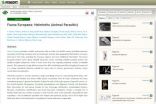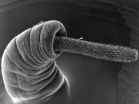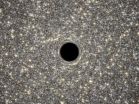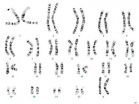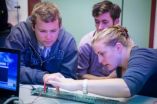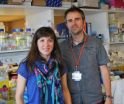(Press-News.org) Fauna Europaea started in 2000 as an EC-FP5 four-year project, delivering its first release in 2004. After 14 years of steady progress and successful participations in several EC projects, as a part of the EC-FP7 European Biodiversity Observation Network project (EU BON), to increase the general awareness of the work done by the contributors and to extend the general dissemination of the Fauna Europaea results, the Biodiversity Data Journal has applied its novel e-Publishing tools to prepare data papers for all 56 major taxonomic groups.
Fauna Europaea provides a public web-service with an index of scientific names (including important synonyms) of all living European land and freshwater animals, their geographical distribution at country level, and some additional information. The Fauna Europaea project covers about 230,000 taxonomic names, including 130,000 species name. This represents a huge effort by more than 400 contributing specialists throughout Europe and is a unique (standard) reference suitable for many users in science, government, industry, nature conservation and education.
'Contributions on Fauna Europaea' is the second series launched by the Biodiversity Data Journal after the Checklist of British and Irish Hymenoptera and the first one that embraces thematic data-papers structured in a common pattern extracted from a large database. This novel publication model will assemble in a single-issue 56 data-papers on different taxonomic groups covered by the Fauna Europaea project in the period 2000-2014 and a range of accompanying papers highlighting various aspects of this project (gap-analysis, software design, taxonomic assessments, etc.).
This is the first collection of data-papers of this scale. It will formalise and effectively publish the results of nearly 500 contributors building the largest European animal (taxonomic) database. The new publication model provides a reliable mechanism for citation and bibliographic indexing of large and uniformly structured databases.
"The publication of Fauna Europaea data papers brings a number of benefits for science, for example it stimulates experts to hand-over descriptive details on their groups, triggers new ways of community networking and participation, motivates experts to update their data, supports a better documentation of their achievements, including issues like 'micro-publications', and increase an ownership feeling with the associated effort" said Dr Yde de Jong, coordinator of the Fauna Europaea and Pan-European Species directories Infrastructure (PESI) projects.
The launch of this large collection of data papers coincides with one more cutting-edge innovation of the Biodiversity Data Journal, the publication of an API, a first of its kind, to import complex and data-rich manuscripts, which include text, data, images, in-text citations, references, in fact anything that a manuscript may contain.
"I am happy that these exciting innovations coincided with the first birthday of the Biodiversity Data Journal. Just a year ago we launched this new concept with the motto: Making your data count! These novel approaches and tools are an excellent example how our concept evolved!" comments Prof. Lyubomir Penev, Managing Director of Pensoft Publishers.
INFORMATION:
Original Sources:
de Jong Y, Verbeek M, Michelsen V, Bjørn P, Los W, Steeman F, Bailly N, Basire C, Chylarecki P, Stloukal E, Hagedorn G, Wetzel F, Glöckler F, Kroupa A, Korb G, Hoffmann A, Häuser C, Kohlbecker A, Müller A, Güntsch A, Stoev P, Penev L (2014) Fauna Europaea – all European animal species on the web. Biodiversity Data Journal 2: e4034. doi: 10.3897/BDJ.2.e4034
Gibson D, Bray R, Hunt D, Georgiev B, Scholz T, Harris P, Bakke T, Pojmanska T, Niewiadomska K, Kostadinova A, Tkach V, Bain O, Durette-Desset M, Gibbons L, Moravec F, Petter A, Dimitrova Z, Buchmann K, Valtonen E, de Jong Y (2014) Fauna Europaea: Helminths (Animal Parasitic). Biodiversity Data Journal 2: e1060. doi: 10.3897/BDJ.2.e1060
Additional information:
The Fauna Europaea project (EVR1-1999-20001) has been funded by the European Commission for a period of four years (1 March 2000 - 1 March 2004) within the Fifth Framework Programme (5FP). Fauna Europaea has assembled a database of the scientific names and distribution of all living multicellular European land and fresh-water animals. The publication of the data papers was supported by the Seventh Framework Programme (FP7) projects Virtual Biodiversity Research and Access Network for Taxonomy (ViBRANT) and European Biodiversity Observation Network project (EU BON).
Pensoft Publishers specialize in academic and professional book and journal publishing, mostly in the field of biodiversity science and natural history. The Biodiversity Data Journal (BDJ) and the associated Pensoft Writing Tool (PWT), were launched by Pensoft as the first workflow ever to put together article authoring, community peer-review, publishing and dissemination within a single online collaborative platform.
Contributions on Fauna Europaea: Data papers as innovative model on expert involvement
2014-09-17
ELSE PRESS RELEASES FROM THIS DATE:
Big surprises can come in small packages
2014-09-17
Astronomers using the NASA/ESA Hubble Space Telescope have found a monster lurking in a very unlikely place. New observations of the ultracompact dwarf galaxy M60-UCD1 have revealed a supermassive black hole at its heart, making this tiny galaxy the smallest ever found to host a supermassive black hole. This suggests that there may be many more supermassive black holes that we have missed, and tells us more about the formation of these incredibly dense galaxies. The results will be published in the journal Nature on 18 September 2014.
Lying about 50 million light-years ...
A link between Jacobsen syndrome and autism
2014-09-17
SAN DIEGO, Calif. (Sept. 17, 2014)— A rare genetic disorder known as Jacobsen syndrome has been linked with autism, according to a recent joint investigation by researchers at San Diego State University and the University of California, San Diego. In addition to suggesting better treatment options for people with Jacobsen syndrome, the finding also offers more clues into the genetic underpinnings of autism.
Jacobsen syndrome affects approximately 1 in 100,000 people, according to the National Institutes of Health. It occurs in a person when there is a deletion at the end ...
Lack of facial expression leads to perceptions of unhappiness, new OSU research shows
2014-09-17
CORVALLIS, Ore. – People with facial paralysis are perceived as being less happy simply because they can't communicate in the universal language of facial expression, a new study from an Oregon State University psychology professor shows.
The findings highlight the important role the face plays in everyday communication and indicates people may hold a prejudice against those with facial paralysis because of their disability, said Kathleen Bogart, an assistant professor of psychology in the College of Liberal Arts at Oregon State University.
"People are more wary and ...
Entrepreneurs aren't overconfident gamblers
2014-09-17
Leaving one's job to become an entrepreneur is inarguably risky. But it may not be the fear of risk that makes entrepreneurs more determined to succeed. A new study finds entrepreneurs are also concerned about what they might lose in the transition from steady employment to startup.
In Entrepreneurship and Loss-Aversion in a Winner-Take-All Society, Professor John Morgan at UC Berkeley's Haas School of Business and co-author Dana Sisak, assistant professor at the Erasmus University Rotterdam, focused on the powerful impact of loss aversion.
Loss aversion, or the fear ...
Oxides discovered by CCNY team could advance memory devices
2014-09-17
The quest for the ultimate memory device for computing may have just taken an encouraging step forward. Researchers at The City College of New York led by chemist Stephen O'Brien have discovered new complex oxides that exhibit both magnetic and ferroelectric properties.
Combining both properties is very exciting scientifically for the coupling that can occur between them and for the devices that might ultimately be designed, in logic circuits or spintronics. Combining these two properties in a single material, however, has proved difficult until now.
Using an innovative ...
Engineers develop algorithms to switch out and recharge battery modules in electric cars
2014-09-17
Imagine being able to switch out the batteries in electric cars just like you switch out batteries in a photo camera or flashlight. A team of engineers at the University of California, San Diego, are trying to accomplish just that, in partnership with a local San Diego engineering company.
They have developed smaller units within the battery, called modules, and a battery management system that will allow them to swap out and recharge the modules, rather than swapping out the whole battery, which is cumbersome and requires large, heavy equipment. They recently presented ...
US health system not properly designed to meet needs of patients nearing end of life, says IOM
2014-09-17
WASHINGTON -- The U.S. health care system is not properly designed to meet the needs of patients nearing the end of life and those of their families, and major changes to the system are necessary, says a new report from the Institute of Medicine. The 21-member committee that wrote the report envisioned an approach to end-of-life care that integrates traditional medical care and social services and that is high-quality, affordable, and sustainable. The committee called for more "advance care planning" for end-of-life by individuals, for improved training and credentialing ...
First blood test to diagnose depression in adults
2014-09-17
CHICAGO --- The first blood test to diagnose major depression in adults has been developed by Northwestern Medicine® scientists, a breakthrough approach that provides the first objective, scientific diagnosis for depression. The test identifies depression by measuring the levels of nine RNA blood markers. RNA molecules are the messengers that interpret the DNA genetic code and carry out its instructions.
The blood test also predicts who will benefit from cognitive behavioral therapy based on the behavior of some of the markers. This will provide the opportunity for more ...
Many throat cancer patients can skip neck surgery
2014-09-17
A new study shows that patients with human papillomavirus (HPV) – the same virus associated with both cervical and head and neck cancer – positive oropharyngeal cancer see significantly higher rates of complete response on a post-radiation neck dissection than those with HPV-negative oropharyngeal cancer. Fox Chase Cancer Center researchers presented the findings at the American Society for Radiation Oncology's 56th Annual Meeting on Wednesday, September 17.
"For patients that achieve a complete response, neck surgery is probably unnecessary," says Thomas J. Galloway, ...
Five genes to predict colorectal cancer relapses
2014-09-17
Researchers at the Catalan Institute of Oncology-Bellvitge Biomedical Research Institute (ICO-IDIBELL), led by David Garcia-Molleví have identified 5 genes differentially expressed in normal accompanying cells in colorectal tumors. Analysis of these genes could be used to classify colorectal tumors, predict the evolution of the patient and thus take appropriate clinical decisions to prevent relapses.
Biomarkers
Colorectal cancer is the most common in our population considering both sexes. About 30,000 new cases are diagnosed each year. Of these, approximately 70% are ...
